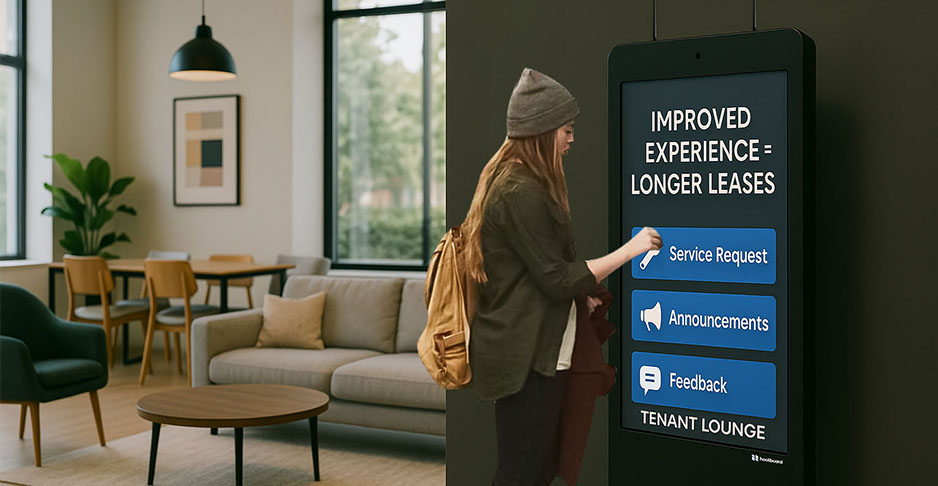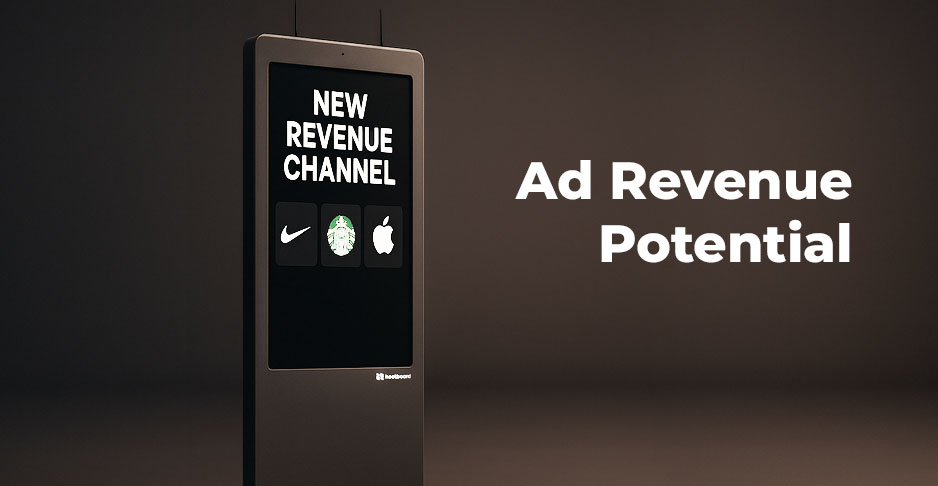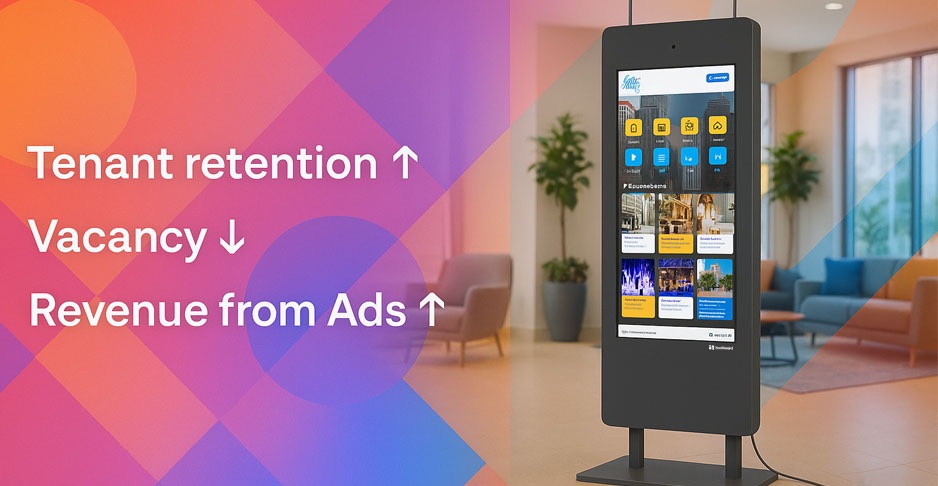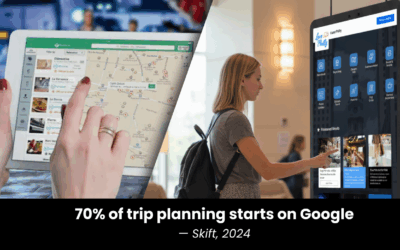NOI Is King
For REITs, value creation revolves around one powerful metric: Net Operating Income (NOI). Whether your portfolio includes residential towers, commercial offices, or mixed-use developments, NOI is the bedrock of your asset’s market value and your investor returns.
Traditionally, REITs have focused on predictable methods to improve NOI—tightening operational costs, increasing rents, optimizing lease cycles. But in an age where tenants expect tech-driven, engaging, and connected spaces, a new lever has emerged: smart kiosks and digital signage.
These tools are no longer “nice-to-haves.” They’re strategic infrastructure—interactive, data-driven platforms that improve tenant retention, reduce vacancy, lower operating costs, and even generate passive revenue.
This article breaks down how HootBoard-powered kiosks and digital signage help REITs unlock NOI growth and long-term asset appreciation.
Why REITs Need to Think Like Tech Companies
REITs that perform well in today’s climate think beyond traditional real estate KPIs. They treat each property like a customer-first product—investing in technology that enhances experience and drives measurable performance.
The shift toward smart infrastructure is not speculative—it’s happening now:
- A PwC and ULI report on Emerging Trends in Real Estate 2024 ranked “Smart Building Technology” as one of the top 5 investment priorities for institutional real estate.
- Deloitte found that REITs implementing smart property tech solutions realized a 5–15% uplift in NOI over a three-year period, primarily due to increased retention and operational efficiency.
Smart kiosks and digital signage are an accessible, scalable entry point into this strategy—requiring low CapEx compared to structural retrofits, but delivering high-impact returns across multiple levers.
The Three NOI Levers Smart Kiosks Influence
Let’s break down how HootBoard kiosks and signage directly influence NOI through three critical real estate levers:
1. Tenant Retention
Keeping tenants is more valuable than acquiring new ones.
A study by JLL found that the cost of tenant turnover in commercial office spaces can range from $25 to $50 per square foot due to downtime, buildouts, and commissions. In residential REITs, vacancy losses and incentives can eat into profit margins quickly.
Smart kiosks directly combat this by improving the tenant experience:
- Real-time information: Building events, maintenance alerts, or service updates.
- Self-service functions: Amenity bookings, visitor management, concierge.
- Community engagement: Event promotion, tenant recognition, feedback collection.
These touchpoints build loyalty—tenants feel heard, informed, and connected.
2. Reducing Vacancy Rates

Leasing velocity is another critical factor in NOI. The faster a space is leased, the faster it contributes to income.
Interactive kiosks help speed up this cycle by:
- Displaying real-time availability
- Showcasing 3D unit tours
- Collecting lead info from walk-ins
- Promoting referral incentives and limited-time offers
They essentially act as 24/7 digital leasing agents, especially in lobbies and high-traffic zones where potential tenants may be browsing casually.
For REITs with multiple assets in one metro, kiosks can even cross-promote vacancies across the portfolio—offering renters or businesses more flexible choices, while keeping units leased and revenue flowing.
3. Unlocking Advertising & Monetization Opportunities

This is where kiosks evolve from a cost center into a revenue generator.
Modern digital signage and interactive kiosks can display:
- Paid ads from local businesses
- Sponsored tenant offers
- Property-wide promotions or upsells
- Internal revenue-generating services (e.g., storage, parking, premium access)
HootBoard’s platform supports ad network integration, giving REITs a path to passive income—especially in high-traffic urban or mixed-use environments.
Operational Efficiency: A Fourth Bonus Lever
While not always reflected immediately in NOI, cost savings from operational efficiency play a key role in long-term profitability. Smart kiosks reduce staff load on routine communications, wayfinding, and tenant inquiries.
Property managers report saving 15–20 staff hours per month per building due to fewer repetitive queries and improved tenant communication via kiosks.
This also improves staff morale and retention, reducing soft costs that often go untracked but add up over time.
Data: The Digital Asset REITs Can’t Afford to Ignore
The smartest REITs today are data-led. They know:
- Who visits their properties and when
- What amenities tenants engage with most
- What announcements get traction
- What causes friction or disengagement
HootBoard kiosks capture anonymized engagement data across all user interactions—giving REITs a unique lens into building performance and tenant behavior.
This data can be used to:
- Inform CapEx decisions
- Optimize marketing
- Adjust staffing and services based on traffic patterns
- A/B test promotional content and incentives
Think of it this way: you can’t improve what you don’t measure. And traditional buildings offer little to no visibility into user experience. Kiosks close that feedback loop.
ESG and Smart Property Strategy
Environmental, Social, and Governance (ESG) concerns are top-of-mind for REIT investors. Smart kiosks support all three pillars:
- Environmental: Digital signage reduces printed flyers, waste, and physical signage turnover.
- Social: Improves accessibility, inclusivity, and tenant engagement.
- Governance: Offers data and audit trails on tenant communications, service usage, and building interactions.
REITs with robust ESG reporting can highlight kiosk usage as part of their sustainability and digital transformation efforts—strengthening investor confidence and potentially increasing valuation multiples.
Portfolio-Wide Scalability
One of the biggest advantages of kiosk deployments is how easily they scale.
With a centralized CMS (Content Management System), HootBoard allows REITs to:
- Deploy consistent messaging across all properties
- Customize local content based on geography
- Remotely update directories, ads, events, and leasing details
- Track performance property-by-property or portfolio-wide
This level of centralized control means that whether you manage 10 properties or 200, your team can orchestrate communications, marketing, and monetization from a single dashboard.
Financial Summary: What a Typical Kiosk Deployment Can Deliver

Let’s walk through a simple NOI-impact scenario for a single mid-rise residential property.
Property Size: 300 Units
HootBoard Kiosk Investment: $5,000/unit (x2 kiosks = $10,000)
Annual Platform Fee: ~$1,200
Annualized Impact:
- Reduced churn by 8% = ~$72,000 NOI gain (based on $1,500 avg rent)
- Ad revenue = $1,200/month = $14,400/year
- Lower front desk staff overtime = ~$6,000 saved annually
Net NOI Increase (Year 1): ~$92,400
Payback period: <2 months
Cap rate uplift (assuming 5% cap):
$92,400 ÷ 0.05 = $1.84M property value increase
This shows how even a small tech investment can produce disproportionately high returns in REIT asset management.
From Passive Properties to Smart Profit Centers
REITs are not just managing buildings anymore. They are managing brands, experiences, and systems of engagement. In this environment, technology is no longer just an efficiency tool—it’s a strategic value multiplier.
HootBoard kiosks and digital signage offer a unique advantage to REITs:
- Boost NOI through tenant retention, monetization, and vacancy reduction
- Enhance ESG, branding, and tenant satisfaction
- Deliver real-time insights that drive smarter asset decisions
- Scale seamlessly across diversified portfolios
In a landscape where margin matters and investors demand more transparency, kiosks are no longer optional—they’re the new operational standard for smart REITs.




